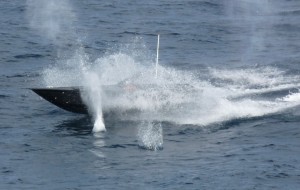As objects of envy go, Hammerhead might seem an odd choice. To the uninitiated (that is, civilian) eye, the five-metre long craft appears at first to be a speedboat, albeit a particularly sinister-looking speedboat, thanks to its matte black colour and low-lying hull.
Look at it more closely, though, and you notice something: no room for passengers. That is not surprising. Hammerhead is a target – a fast and maneuverable target that, as a result, is exceedingly difficult to deal with.
That’s where the envy comes in. Built by Meggitt Training Systems Canada for the Royal Canadian Navy, Hammerhead gives the fleet a training tool for firing live ammunition at a live target that many other navies can only dream of. This July, some of them had a chance to try it.
When HMCS Calgary sailed from San Diego as part of the run-up to this year’s Rim of the Pacific (RIMPAC) exercise with nine other vessels, including ships from Chile, Norway, and the United States navy and coast guard, she carried six Hammerheads on board. Calgary launched two of her stock to give the participating ships a chance to see how Hammerhead operated. The Norwegian frigate Fridtjof Nansen managed to bag one, while American and Chilean vessels succeeded in disabling another, which was ultimately dispatched by a helicopter.
For those who participated, it was a rare chance to train with such a realistic and slippery target. Speaking with Jane’s Defence Weekly, Canadian Rear-Admiral Gilles Couturier said, “All of our friends that get the opportunity to shoot that [the Hammerhead] are really, really happy with the performance of the target.”
First brought into use by the navy in February 2009, Hammerhead was created to prepare sailors for one of the prime challenges of modern naval warfare: battling not a deep water force, but the swarms of fast inshore attack craft (FIAC) that a warship might encounter supporting land operations in the contested littorals. With one major difference: because the RCN trains in the open sea, Hammerhead was specifically designed to work in relatively rougher conditions, and is capable of speeds of up to 35 knots in sea state three (waves in excess of a meter in height) and even faster in calmer waters.
Relatively lightweight at 900 kilograms, Hammerhead target vessels are commonly carried aboard ship, and controlled when launched by a universal target control station installed on the bridge. From this station, the operator can track the target vessel either by line of sight or even over the horizon, up to a distance of five nautical miles. (Saying “operator” here is actually a little misleading. They essentially set the Hammerhead to run, utilizing a variety of possible patterns – straight on high speed attacks, zig-zag, crossing patterns and so forth – and then devote themselves to monitoring the vessel’s behaviour.)
Thanks to Hammerhead’s portability and onboard control station, a ship can undertake target training when and as conditions allow. A single target station can control four separate vessels, although through networking it is possible to have more operating at once. John LeBlanc, Meggitt’s RCN program officer, says that for a 2010 swarm exercise at CFB Esquimalt, the navy had 16 Hammerheads operating simultaneously and it is possible to have up to 40. Although primarily intended to emulate a FIAC, with different payloads the vessel is capable of acting as a range of different possible targets.
But perhaps Hammerhead’s most surprising feature, at least for the outsider, is one you might not even think of. “The idea is to sink it,” says LeBlanc.
This is not common. With most naval gunnery targets the idea is to get close – but not too close. Not Hammerhead. And as a result, says navy spokesperson Ashley Lemaire, “the training value is significantly increased, particularly when compared to other targets where sailors unfortunately have to ‘shoot to miss.’”
As the RCN increasingly emphasizes littoral warfare, Hammerhead’s importance as a training aid – and even as a tool for evaluation – can only increase. Beginning in 2010, the navy’s twelve patrol frigates have been undergoing mid-life refits. The Halifax-class Modernization/Frigate Equipment Life Extension (HCM FELEX) project is intended, among other things, to provide these ships with the sensors, communications and other systems to improve their ability to fight in littoral conditions. And what better way to test them than against Hammerhead?
Calgary’s remaining four Hammerheads were put into action after RIMPAC, to evaluate her post-refit performance, the first real chance to do so since she rejoined the fleet. Says Lemaire, “Because of their high speed, maneuverability and emulation of small surface threats, these four Hammerhead targets proved ideal for trialing Calgary’s modernized systems.”
An enviable asset, indeed.
Ian Coutts is a freelance writer, author of four books, and a frequent contributor to Vanguard.

